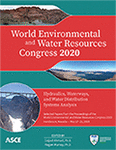World Environmental and Water Resources Congress 2020
Modeling Dynamic Consumer Decisions during Disruptions of Intermittent Water Supply Systems
Publication: World Environmental and Water Resources Congress 2020: Hydraulics, Waterways, and Water Distribution Systems Analysis
ABSTRACT
Millions of people around the world rely on intermittent water supply systems (IWS) where water supply is limited to specific hours during the day or to specific days in the week. During physical disruptions of the water network, the variables that affect consumer decisions are dynamic, and consumer behavior is affected by the attributes (in particular, length, and intensity) of the disruption. This study analyzes the short-term decision-making process of residential water consumers in a city in the Middle East. In this city, consumers have long adapted to the intermittency of water supply by installing household water storage with various capacities. However, the volumes of the stored water are often not sufficient to supply the regular household demand for the duration of the disruption, and consumers have to take actions regarding their water supply and/or water consumption. Based on the results of a survey of more than 250 households, a set of binary probit models were developed to model consumers’ decisions related to the timing of their responses to the disruption, their willingness to pay for faster delivery of water using tankers, and their willingness to pay to avoid waiting in-line at the tankers’ location. The results of the analysis show how variables such as household characteristics, tankers’ prices and waiting times, consumers’ knowledge of their households’ water situation, prior experience with disruptions, and socioeconomic parameters affect the consumers’ decisions when the piped IWS is disrupted.
Get full access to this article
View all available purchase options and get full access to this chapter.
REFERENCES
Acharya, G., and Barbier, E. (2002). “Using Domestic Water Analysis to Value Groundwater Recharge in the Hadejia-Jama’are Floodplain, Northern Nigeria.” American Journal of Agricultural Economics, 84(2), 415–426.
Cheesman, J., Bennett, J., and Son, T. V. H. (2008). “Estimating household water demand using revealed and contingent behaviors: Evidence from Vietnam.” Water Resources Research, 44(11), 1–11.
Coulibaly, L., Jakus, P. M., and Keith, J. E. (2014). “Modeling water demand when households have multiple sources of water.” Water Resources Research, 50(7), 6002–6014.
Kaminsky, J., and Kumpel, E. (2018). “Dry pipes: Associations between utility performance and intermittent piped water supply in low and middle income countries.” Water (Switzerland), MDPI AG, 10(8).
Larson, B., Minten, B., and Razafindralambo, R. (2006). “Unravelling the linkages between the millennium development goals for poverty, education, access to water and household water use in developing countries: Evidence from Madagascar.” Journal of Development Studies, 42(1), 22–40.
Majuru, B., Suhrcke, M., and Hunter, P. R. (2016). “How do households respond to unreliable water supplies? a systematic review.” International Journal of Environmental Research and Public Health, 13(12).
Mimi, Z., and Smith, M. (2000). “Statistical domestic water demand model for the west bank.” Water International, 25(3), 464–468.
Nauges, C., and Van Den Berg, C. (2009). “Demand for piped and non-piped water supply services: Evidence from southwest Sri Lanka.” Environmental and Resource Economics, 42(4), 535–549.
Nauges, C., and Strand, J. (2007). “Estimation of non-tap water demand in Central American cities.” Resource and Energy Economics, 29(3), 165–182.
Rosenberg, D. E., Tarawneh, T., Abdel-khaleq, R., and Lund, J. R. (2007). “Modeling integrated water user decisions in intermittent supply systems.” Water Resources Research, 43(February), 1–15.
Salman, A., Al-Karablieh, E., and Haddadin, M. (2008). “Limits of pricing policy in curtailing household water consumption under scarcity conditions.” Water Policy, 10(3), 295–304.
Srinivasan, V., Gorelick, S. M., and Goulder, L. (2010). “A hydrologic-economic modeling approach for analysis of urban water supply dynamics in Chennai, India.” Water Resources Research, 46(7), 1–19.
Tabieh, M., Salman, A., Al-karablieh, E., and Al-qudah, H. (2012). “The Residental Water Demand Function in Amman- Zarka Basin in Jordan.” Wulfenia Journal, 19(11), 324–333.
Thneibat, M. M. (2016). “Policy Design Tool for Managing Indoor Residential Water Demand in Water-Scarce Regions.” PhD Dissertation, Purdue University, West Lafayette, IN.
Washington, S., Karlaftis, M., and Mannering, F. (2010). Statistical and econometric methods for transportation data analysis. Chapman and Hall/CRC.
Whittington, D., and Nauges, C. (2010). “Estimation of Water Demand in Developing Countries: An Overview.” World Bank Research Observer, 25(August), 263–294.
Information & Authors
Information
Published In
World Environmental and Water Resources Congress 2020: Hydraulics, Waterways, and Water Distribution Systems Analysis
Pages: 360 - 373
Editors: Sajjad Ahmad, Ph.D., and Regan Murray, Ph.D.
ISBN (Online): 978-0-7844-8297-1
Copyright
© 2020 American Society of Civil Engineers.
History
Published online: May 14, 2020
Published in print: May 14, 2020
Authors
Metrics & Citations
Metrics
Citations
Download citation
If you have the appropriate software installed, you can download article citation data to the citation manager of your choice. Simply select your manager software from the list below and click Download.
